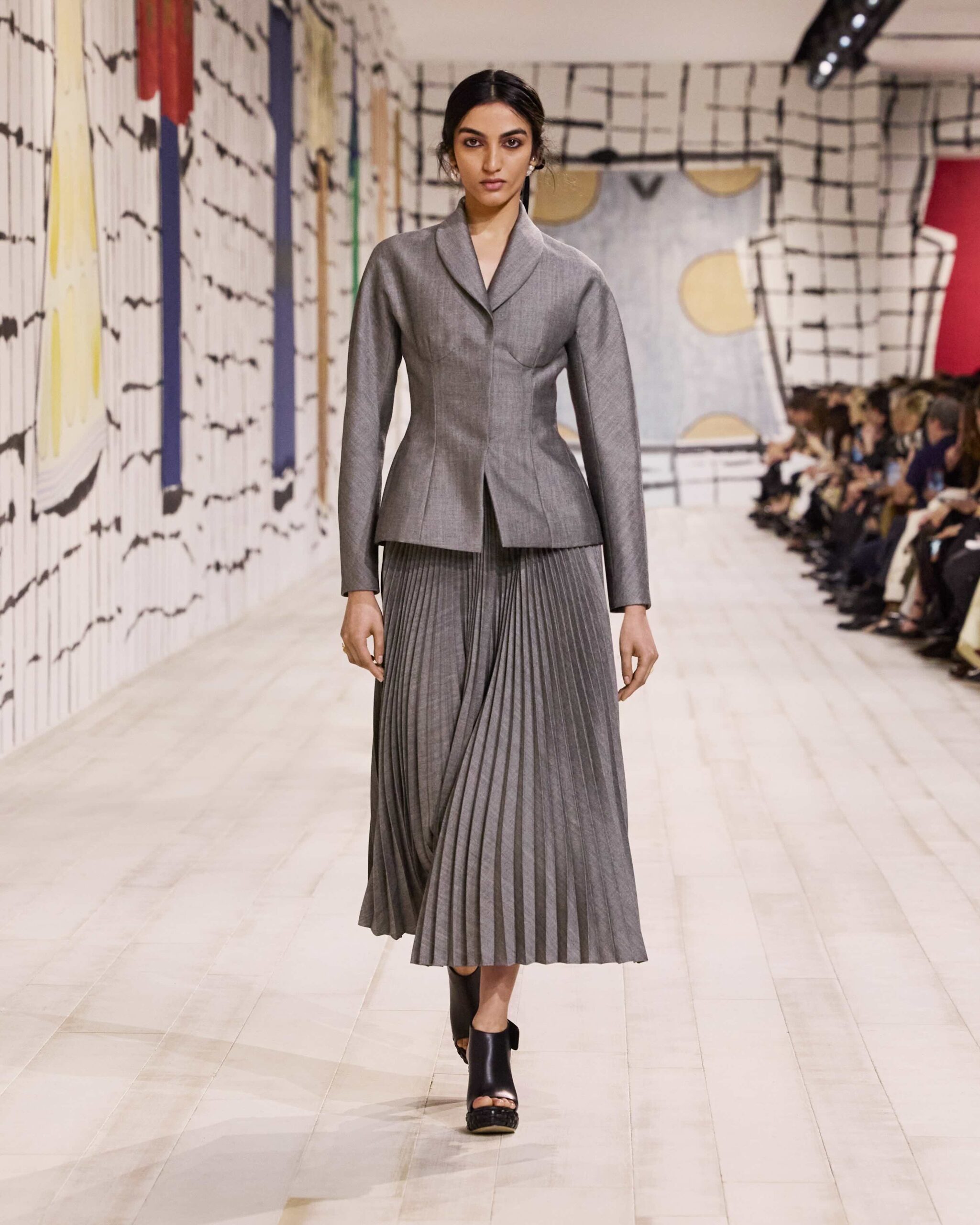Rag or brocade
every women textile thus results
from this enforced embrace, a grand design
that only human minds are meant to grasp
and execute; and thus a marriage that
could not in nature ever find its place.
Take the spider, poor thing. It dupes.
The spider doesn’t weave; the spider glues. – Patrizia Cavalli
Maria Grazia Chiuri knew Isabella Ducrot through Patrizia Cavalli’s poem, which recounted the artist’s fascination with the checkered pattern as an expression of the relationship between warp and weft. The primordial skein, in fact, represents a symbolic starting point for both Ducrot and Chiuri, both investigating warp and weft as a collective human experience. Referring to Penelope and her continual making and unmaking of the loom, the two creatives reflect together on time and fabric and their inexorable bond, represented graphically in the fashion show set design by its characteristic checkered pattern: the warp and weft. Surrounded and immersed by artist Isabella Ducrot’s large installations of outsized dresses, Maria Grazia Chiuri’s Haute Couture collection once again empties and lightens Monsieur Dior’s clothes, presenting an irrepressible passion for fabrics. Twenty-three dresses about five meters high, applied on a grid designed by irregular black stripes that refer to warp and weft are the memory of the dresses of the Ottoman sultans seen by Ducrot in Istanbul. An abstraction of dress, a symbol of a power that transcends bodies, Big Aura is for Maria Grazia Chiuri that aura that effuses every single artifact of haute couture. The aura in Walter Benjamin’s clarification, which Chiuri and Ducrot refer to in different ways, reflects the uniqueness and authenticity of the work of art. And it places it in the collective memory. Chiuri decides to reactivate the concept of aura through haute couture that is inherent in the essence of Dior: a Maison that represents charisma and history.

“When I work at Couture I feel in conversation with real bodies, real women. I prefer to work with real proportions, and with more wearable constructions.”
Questioning the fine line between art and life is the La Cigale gown from the 1952 fall-winter haute couture collection in its sculptural construction and moiré fabric, which in its texture references the sacred; it becomes the manifesto and starting point of the collection, a theory of models that recontextualize couture in the sacredness of the atelier. Haute Couture remains the territory of contemplative rapture in which the reproduction of the original is never the same, obliged as it is to adapt in each of its reproductions to the bodies of those who will be able to possess it. Moiré is one of the protagonists of Chiuri’s presentation: it is used in a striking color palette that enhances its sculptural quality and material iridescence: gold, white, gray, burgundy, green. The geometric lines of La Cigale echo all the clothes that impose a pose: coats with important collars, but also wide skirts that allow themselves exaggerated folds, overlays, pants, jackets. The pattern-making takes up elements from archives reworking the codes in a more modern vision. It also happens with materials such as cotton and silk in trench coats, which seem to be shaped by the air because of the relationship they have between the body and the surroundings. Some dresses made of black velvet enhance the allure of the wearer, moving fluidly and lightly. While a sumptuous feather cape rests on an embroidered double organza gown. Embroideries are for Dior’s women’s designer worn fragments of found poems in which the imagination loses itself, and the art of sewing its joy. Occasionally they explode in the colorful variety of nature, in the Millefiori that occupies the entire space of a yellow moiré dress.


Sometimes, instead, they are locks with long strands that sway in the rhythm of steps. In this collection, Maria Grazia Chiuri – through the material, chromatic, constructive presence of the elements that sculpt the silhouettes-reminds us again of the notion of “Aura and Choc” a famous text by Walter Benjamin, reworked for an auratic dimension of couture: a powerful experience, not only contemplative but also performative. For all intents and purposes an expression of the transformative spirit of imagination. Chiuri’s practice of collaborating each time in a duo, between art and fashion, is in itself something that will always bring to light new languages and congestions. In this way, Dior through an act of imagination – that is fashion – has created a new world in which to negotiate knowledge about the investigation of the feminine.















